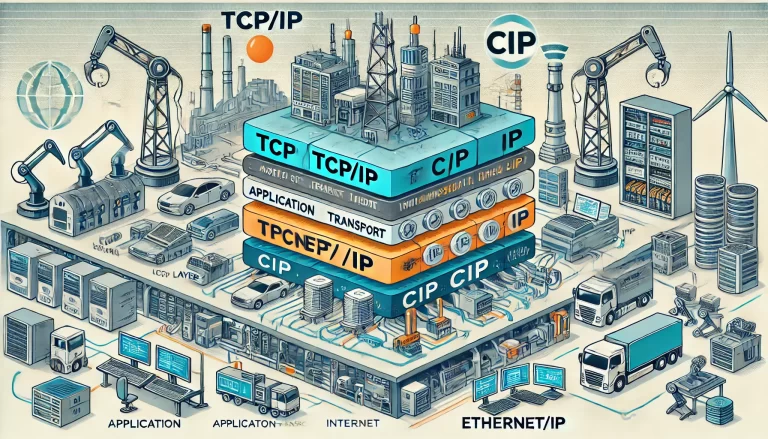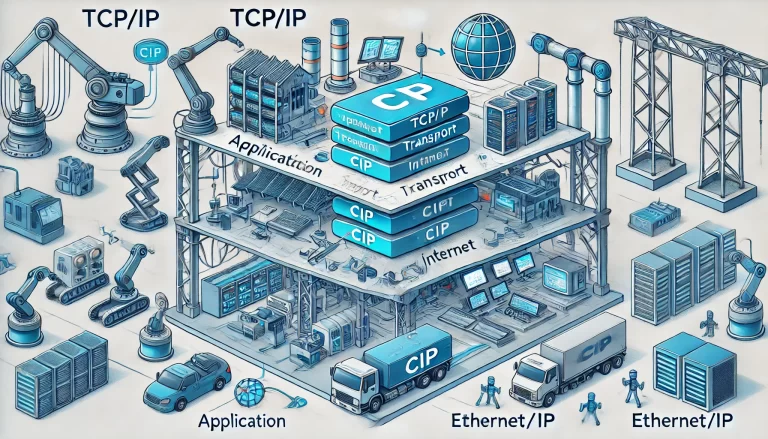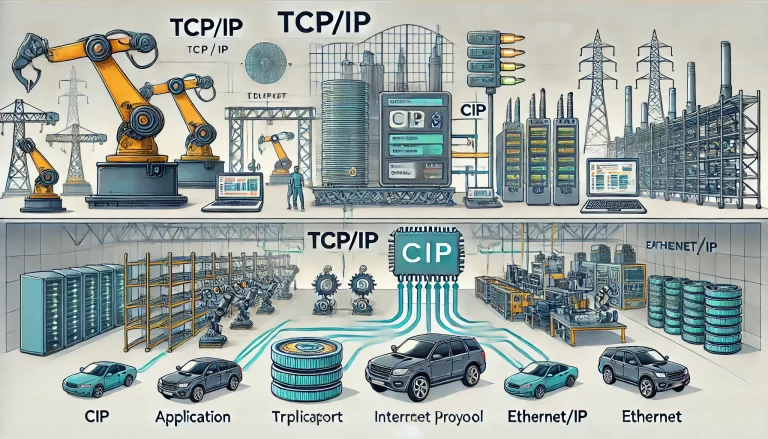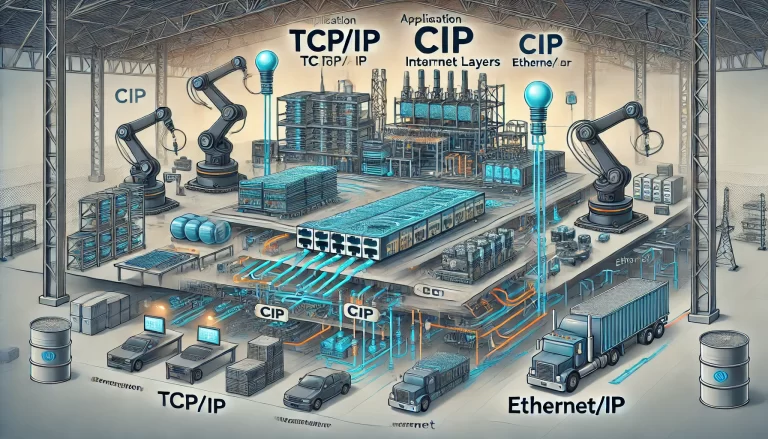When dealing with networking technologies, especially in industrial settings, three terms often come up: TCP/IP, CIP, and EtherNet/IP. Although these protocols interact in different ways, each plays a specific role in communication systems, particularly in automation and industrial control environments. This article will explore the differences and applications of these three protocols to give you a clearer understanding of their distinct purposes and how they work together.
1. TCP/IP (Transmission Control Protocol/Internet Protocol)
TCP/IP is a fundamental communication protocol used to connect devices on the internet and most internal networks. It defines how data is sent and received over a network, ensuring reliable and organized data transmission. TCP/IP is the backbone of most modern network communication.
Key Characteristics of TCP/IP:
- Layered Model: TCP/IP operates using a layered approach, which is broken down into four main layers:
- Application Layer (e.g., HTTP, FTP)
- Transport Layer (e.g., TCP, UDP)
- Internet Layer (e.g., IP, ICMP)
- Link Layer (e.g., Ethernet)
- Connection-Oriented: TCP (Transmission Control Protocol) ensures reliable communication by establishing a connection between devices before transmitting data. It guarantees that packets are delivered correctly and in the right order.
- Versatility: TCP/IP is designed for a wide range of network types, including local area networks (LANs) and the internet. It’s used for general-purpose communication and is found in applications like web browsing, email, file transfer, and more.
Applications of TCP/IP:
- Internet communications
- Web services
- Enterprise network infrastructure
- Communication between computers and servers

2. CIP (Common Industrial Protocol)
CIP, or Common Industrial Protocol, is a protocol designed for use in industrial automation applications. It provides a set of services and messaging for real-time control of automated systems, focusing on the transmission of both real-time control data and diagnostic information.
Key Characteristics of CIP:
- Application-Layer Protocol: CIP is an application-layer protocol, which means it operates at the highest layer of the TCP/IP model. It handles the format and semantics of data exchanges between devices in an industrial network.
- Device Profiles: CIP is device-independent and defines a set of object models that are used for various types of automation devices, such as sensors, actuators, and controllers.
- Real-Time Data: It is designed for real-time data exchange, which is crucial in industrial automation where timely and deterministic communication is essential.
- Multimedia Services: CIP supports the integration of different types of data, including control, safety, motion, configuration, and diagnostics, all within the same network.
Applications of CIP:
- Factory automation systems
- Industrial control systems
- Process automation
- Motion control in robotic systems

3. EtherNet/IP (Ethernet Industrial Protocol)
EtherNet/IP is an implementation of CIP over standard Ethernet and TCP/IP. It combines the robustness of the CIP protocol with the versatility and widespread adoption of Ethernet networking. EtherNet/IP allows real-time control and data exchange over standard Ethernet, which is crucial in industrial environments.
Key Characteristics of EtherNet/IP:
- Uses Standard Ethernet: Unlike proprietary industrial Ethernet solutions, EtherNet/IP operates over standard IEEE 802.3 Ethernet. This makes it compatible with standard networking equipment like switches, routers, and cables.
- Integration of CIP: EtherNet/IP uses the CIP application layer over the TCP/IP and Ethernet layers. Essentially, it allows CIP messages to be transmitted over standard Ethernet, enabling interoperability between industrial and IT systems.
- Deterministic Control: While Ethernet by itself isn’t inherently deterministic, EtherNet/IP adds mechanisms to ensure that critical control data is delivered in real-time. It does this using multicast communication for time-sensitive messages.
- High Scalability: EtherNet/IP is highly scalable, supporting small-scale systems with a few devices to large-scale industrial networks with thousands of devices.
Applications of EtherNet/IP:
- Real-time control in manufacturing systems
- Factory automation
- SCADA (Supervisory Control and Data Acquisition) systems
- Integration of industrial devices with enterprise-level IT systems

Differences Between TCP/IP, CIP, and EtherNet/IP
Purpose:
- TCP/IP is a general-purpose protocol used for communication on the internet and within internal networks.
- CIP is a specialized protocol used in industrial automation, focusing on real-time control and diagnostic data.
- EtherNet/IP combines CIP with TCP/IP over Ethernet, allowing CIP to be used in Ethernet-based industrial networks.
Layer of Operation:
- TCP/IP operates across multiple layers (Application, Transport, Internet, and Link layers).
- CIP is an application-layer protocol, built to work on top of lower-level transport protocols like TCP/IP or UDP.
- EtherNet/IP uses TCP/IP and Ethernet as its transport layers but adds CIP as the application layer for real-time control data.
Real-Time Communication:
- TCP/IP doesn’t inherently support real-time communication, which can lead to delays in industrial applications.
- CIP is designed for real-time communication in industrial environments.
- EtherNet/IP provides real-time capabilities over Ethernet by using CIP for data exchange and introducing deterministic mechanisms.
Scope:
- TCP/IP is used globally in IT and consumer applications, from web browsing to email.
- CIP is exclusively used in industrial environments for automation, diagnostics, and control.
- EtherNet/IP is used to integrate industrial automation devices and systems with Ethernet-based networks and IT infrastructure.

Conclusion
Each protocol serves a unique purpose, with TCP/IP functioning as the core communication protocol for global networks, CIP focusing on real-time communication in industrial settings, and EtherNet/IP bridging the gap by bringing CIP into the world of Ethernet and TCP/IP. Understanding the differences between TCP/IP, CIP, and EtherNet/IP is essential for selecting the right protocol for a given industrial or IT application, ensuring efficient and reliable communication in the intended environment.
